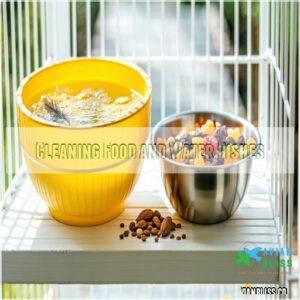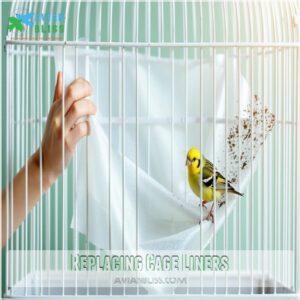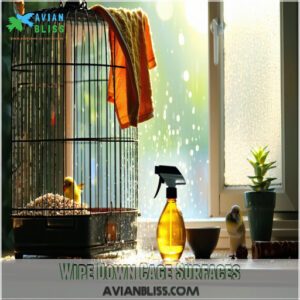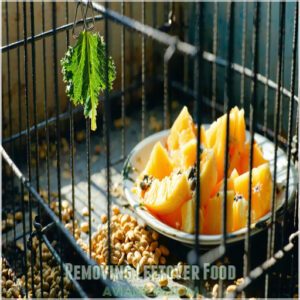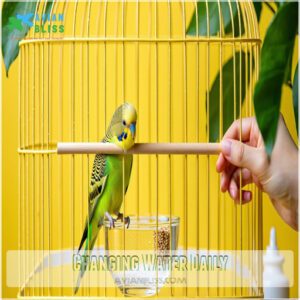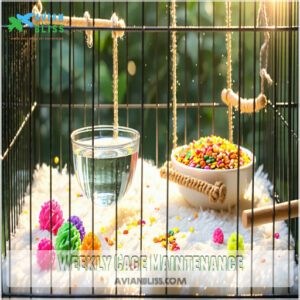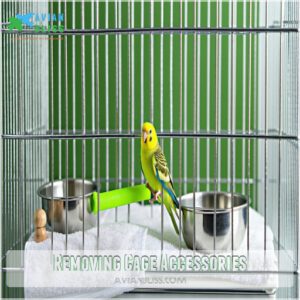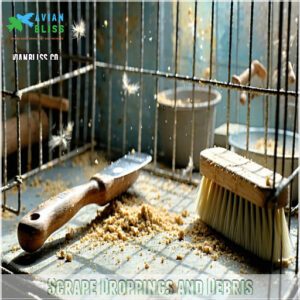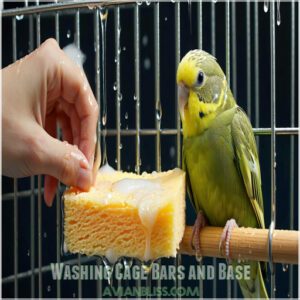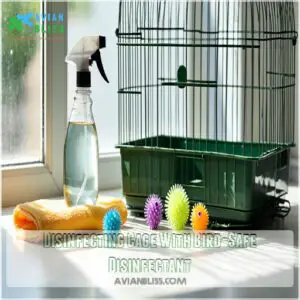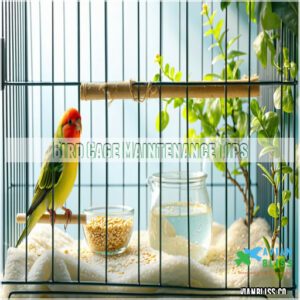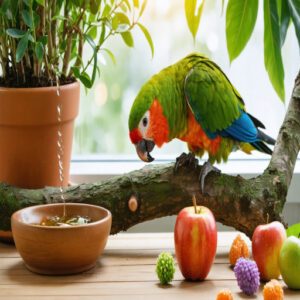This site is supported by our readers. We may earn a commission, at no cost to you, if you purchase through links.
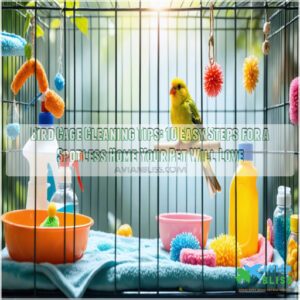
Start by changing food and water daily to keep things fresh and bacteria-free. Swap out cage liners every day too—newspaper works great and won’t break the bank.
Wipe down the cage with a bird-safe cleaner, focusing on bars, corners, and perches where debris loves to hide. Toss any uneaten food before it spoils, and take a few minutes each week to scrub the cage tray and toys.
A clean cage means a happy, healthy bird—and less mess for you. Start small, but stay consistent!
Table Of Contents
- Key Takeaways
- Daily Cage Cleaning
- Weekly Cage Maintenance
- Deep Cleaning Procedures
- Bird Cage Maintenance Tips
- Frequently Asked Questions (FAQs)
- How to clean a pet bird cage?
- Is it safe to clean a bird cage?
- Why do birds need a clean cage?
- How often should you clean your bird cage?
- How to take care of a bird cage?
- How do you clean a bird cage grate?
- What is the best thing to clean a bird cage with?
- How often should a bird’s cage be cleaned?
- Should I wear a mask when cleaning bird cage?
- How can I prevent cage odor buildup?
- Conclusion
Key Takeaways
- Replace cage liners daily, clean food and water dishes, and wipe down surfaces to prevent bacteria buildup and mess.
- Scrub perches, toys, and the cage tray weekly with bird-safe cleaners to maintain hygiene and keep your bird healthy.
- Deep clean the entire cage monthly by disassembling parts, scraping debris, and using bird-safe disinfectants to remove hidden germs.
- Always use mild, bird-safe cleaning products, rinse thoroughly, and let everything dry completely to ensure a safe environment.
Daily Cage Cleaning
You’ll need to clean your bird’s cage daily to keep your feathered friend healthy and happy in their home.
A quick daily cleaning routine, which includes changing food and water, wiping surfaces, and removing waste, won’t take more than 15 minutes of your time, and is crucial for maintaining a clean environment, thus a quick daily routine is essential.
Cleaning Food and Water Dishes
Your bird’s food and water dishes are their dining room – keeping them clean is essential for your feathered friend’s health.
A balanced diet is important for a bird’s well-being.
Here’s your daily dish-cleaning ritual:
- Remove dishes and leftover contents
- Wash thoroughly with mild dish soap and warm water
- Scrub away stuck-on food particles and debris
- Rinse completely until water runs clear
- Dry thoroughly before refilling with fresh food and water
These simple steps make sure your bird’s bowls stay as spotless as a five-star restaurant’s finest china, which is crucial for your bird’s well-being and overall health.
Replacing Cage Liners
Starting fresh each morning, replace your bird cage liner to maintain a clean, odor-free environment.
You’ll want to choose the right materials and sizes for effective waste removal. Convenient bird cage liners are available online.
Here’s a quick guide to help you select the perfect liner:
| Liner Material | Benefits | Drawbacks | Cost | Availability |
|---|---|---|---|---|
| Newspaper | Affordable, absorbent | Can be messy | $ | Easy to find |
| Paper towels | Quick cleanup | Less eco-friendly | $$ | Widely available |
| Commercial liners | Pre-cut, durable | More expensive | $$$ | Pet stores |
| Kraft paper | Sturdy, natural | May need cutting | $$ | Office supplies |
| Recycled paper | Eco-friendly | Variable quality | $ | Limited sources |
This guide provides an overview of different liner materials, including their benefits and drawbacks, to help you make an informed decision for your bird’s cage.
Wipe Down Cage Surfaces
With a damp cloth in hand, you’ll want to tackle those cage surfaces daily to keep your feathered friend’s home sparkling clean.
Use bird-safe cleaner on the bars and perches, paying special attention to spots with stuck-on debris.
Don’t forget to wipe down the cage’s corners and crevices where droppings tend to accumulate.
A quick daily wipe-down prevents buildup and makes your weekly deep cleans much easier.
Removing Leftover Food
After wiping surfaces clean, you’ll want to tackle those leftover seeds and food bits.
It’s amazing how quickly food waste can pile up!
Remove any uneaten fresh food from your feathered friend’s dishes on a strict daily schedule.
This prevents spoilage and keeps those pesky bacteria at bay.
Plus, clearing old food helps you track your bird’s eating habits and maintain a proper feeding schedule.
This process is crucial for the health and well-being of your bird, as it allows you to monitor their intake and ensure they are receiving the nutrients they need, thereby preventing potential health issues related to improper feeding.
Changing Water Daily
Everyone knows fresh water is critical for your bird’s daily hydration needs.
You’ll want to completely change the water supply each morning to prevent harmful bacteria growth and make sure the best water quality.
Keep your feathered friend healthy with clean bowls and proper water safety practices.
- Use filtered water when possible to avoid potential contaminants
- Rinse bowls thoroughly before refilling to remove debris
- Check water levels throughout the day, especially during hot weather
Weekly Cage Maintenance
You’ll need to set aside about 30 minutes each week to give your bird’s cage the thorough cleaning it deserves.
During this weekly maintenance routine, you’ll tackle important tasks like scrubbing the cage tray, cleaning perches, and rotating toys to keep your feathered friend healthy and happy.
Cleaning Cage Tray
With your feathered friend’s health in mind, you’ll need to tackle that cage tray weekly.
Here’s a simple guide to keeping it spotless:
| Task | Time Needed | Supplies |
|---|---|---|
| Remove debris | 5 mins | Paper towels |
| Scrub surface | 10 mins | Bird-safe cleaner |
| Disinfect | 15 mins | Vinegar solution |
For best results, lift out the tray completely and use hot, soapy water to remove stuck-on debris.
Convenient bird cage tray cleaner products are also available.
Don’t forget to dry thoroughly before replacing, and remember to use hot, soapy water for effective cleaning, which is a simple process.
Scrubbing Cage Gate
Once you’ve finished the tray, it’s time to tackle those pesky dried droppings on your cage gate.
You’ll need a good scrub brush and some warm, soapy water for this weekly gate maintenance task.
Work systematically from top to bottom, paying extra attention to corners where debris loves to hide.
Don’t forget to rinse thoroughly – your bird’s safety depends on a chemical-free environment.
This task requires careful attention to detail to ensure your bird’s health and safety, making proper cleaning essential.
Cleaning Perches and Toys
Take special care with your bird’s favorite hangout spots – those perches and toys need a thorough weekly cleaning.
Similar bird house cleaning tips apply to cages.
Soak everything in hot, soapy water to remove droppings and debris. Don’t forget to scrub those hard-to-reach nooks where bacteria love to hide.
A quick rinse with bird-safe disinfectant keeps everything sanitary. Let each item dry completely before returning them to your feathered friend’s home.
Rotating Toys and Accessories
Your bird’s toys and accessories need regular rotation to keep them engaged and healthy.
As part of your weekly cage cleaning routine, swap out old toys for fresh ones to prevent boredom.
When you’re doing this plaything exchange, give each item a thorough cleaning with bird-safe soap.
This cage variety isn’t just about enrichment – it’s also perfect timing to inspect toys for wear and damage.
This process is crucial for maintaining your bird’s overall well-being, ensuring they remain engaged and healthy.
Deep Cleaning Procedures
You’ll want to give your bird’s cage a thorough deep clean once a month to keep it spotless and germ-free.
While your feathered friend enjoys some supervised outdoor time, you can tackle all those tough spots that need extra attention, like dried droppings and hidden debris in corners, to keep it spotless.
Removing Cage Accessories
Start your deep cleaning journey by carefully removing every accessory from your cage. You’ll need a systematic approach to cage disassembly to make sure nothing gets overlooked during the cleaning process.
Remember to gather all your cage cleaning supplies before you begin.
- Place food and water dishes in a designated cleaning bucket
- Remove perches one at a time, noting their original positions
- Collect all toys and enrichment items
- Set aside the cage grate for thorough sanitizing
- Organize removable trays and bottom panels separately
Scrape Droppings and Debris
Scrape droppings and debris regularly to keep your cage looking fresh and safe.
Use a putty knife or scraper for dried messes. Pay attention to corners and edges where waste builds up.
A gentle debris scrub with a soft brush helps loosen stubborn spots.
Staying on top of Droppings Removal makes Mess Cleanup easier and maintains a sanitary environment for your bird.
Washing Cage Bars and Base
To clean bird cage bars and the base, use warm, soapy water and a mild sponge.
For particularly stubborn grime, consider a specialty cage bar cleaner.
Metal polishing creates smooth surfaces, while grate cleaning removes stuck debris.
Scrub gently to avoid damage, following your cage cleaning schedule.
Rinse everything thoroughly, leaving no residue.
These bar cleaning tips help maintain a spotless home, resulting in effective cage sanitizing and proper bird cage maintenance.
Disinfecting Cage With Bird-Safe Disinfectant
When disinfecting the cage, use bird-safe cleaning supplies or a homemade bird cage cleaner and vinegar solution.
Dirty cages can attract pests and harbor bacteria, so regular cleaning is essential.
For more detailed instructions, review this helpful cleaning guide.
Disinfection methods matter—avoid harsh chemicals and focus on cage sanitizing with gentle solutions.
After cleaning, rinse thoroughly to maintain bird safety, and let everything air-dry completely before reassembly.
Regular bird cage disinfection keeps your pet healthy and their home fresh!
Bird Cage Maintenance Tips
Keeping up with bird cage maintenance makes life easier for you and healthier for your feathered friend.
From washing accessories daily to adding clever features like plexiglass walls, a few simple steps can keep your bird’s home clean and comfortable.
Filling Dishes With Appropriate Food
Making sure your bird gets a balanced diet is key!
Always fill bird cage dishes with the right food portions. Here’s a guide:
- Use bird cage pellets for nutrient balance.
- Add fresh fruits sparingly for variety.
- Choose seed types based on your bird’s breed.
- Check water quality daily.
- Monitor uneaten food during bird cage upkeep.
The importance of a balanced diet for your bird cannot be overstated.
Washing Cage Accessories Daily
Don’t skip daily rinsing regarding cleaning bird perches, toys, and other accessories.
Use mild soap selection and warm water for gentle scrubbing. Birds explore with their beaks, so accessory sanitizing keeps them healthy.
Regular toy cleaning makes sure a fun, bacteria-free environment. Start each day fresh—it’s a small step with big benefits for cage maintenance and bird safety.
Installing Plexiglass Walls
Plexiglass walls are a game-changer for mess prevention.
Installing these around your cage acts as a sturdy seed guard, keeping food and feathers contained.
They’re easy to clean and maintain bird safety by eliminating sharp edges.
Consider plexiglass cage modifications to reduce mess.
Add this simple upgrade to your bird cage cleaning tips for a tidier space and smoother cage maintenance, complementing your bird cage cleaning schedule perfectly, making it a great addition to your bird cage cleaning schedule with a focus on mess prevention.
Making a Treat Platform With Bird-Safe Wood
A treat platform adds bird enrichment while keeping treats neat.
Choose bird-safe wood like untreated pine—no pesticides or chemicals! Consider optimal birdhouse placement for best results.
Cut and sand the wood to remove splinters. Secure it inside the cage, avoiding sharp edges.
This handy accessory keeps sticky messes off bars and doubles as extra perch space. Combine it with bird safe cleaning supplies for easy maintenance.
Frequently Asked Questions (FAQs)
How to clean a pet bird cage?
Clean your bird’s cage daily by replacing liners, wiping surfaces, and washing dishes.
Weekly, scrub perches, grate, and toys.
Monthly, deep clean everything with bird-safe products. Freshness, hygiene, and fewer pests keep your bird healthy!
Is it safe to clean a bird cage?
Absolutely, it’s safe if you use bird-safe cleaners, rinse everything well, and make sure there’s good ventilation.
Avoid harsh chemicals like bleach, wear gloves for protection.
Keep your feathered friend away until everything’s clean and dry.
Why do birds need a clean cage?
A clean cage keeps your bird happy, healthy, and hygienic.
Dirty cages breed bacteria, attract pests, and create odors.
Regular cleaning minimizes illness risks, prevents messes, and guarantees your feathered friend thrives in a safe environment, which is essential for keeping your bird healthy.
How often should you clean your bird cage?
You should spot-clean your bird’s cage daily, scrub key areas weekly, and deep clean everything monthly.
This routine keeps your bird healthy, prevents odors, and minimizes germs.
A clean cage equals a happy bird!
How to take care of a bird cage?
Did you know dirty bird cages can triple the risk of illness?
Replace liners daily, wipe surfaces, clean perches weekly, and deep-clean monthly.
Use bird-safe cleaners, rinse thoroughly, and always maintain fresh food and water, to prevent the risk of illness.
How do you clean a bird cage grate?
Slide the grate out, scrub it with warm, soapy water, and use a stiff brush for stubborn spots.
Rinse thoroughly, dry completely, and don’t forget gloves—those grates can get pretty messy!
What is the best thing to clean a bird cage with?
Think of a bird cage like a tiny home—it needs TLC.
Use warm water, mild dish soap, or bird-safe cleaners.
Avoid harsh chemicals.
Rinse thoroughly and air dry to protect your feathered friend.
How often should a bird’s cage be cleaned?
You should clean your bird’s cage daily by replacing liners, washing dishes, and wiping surfaces.
Do a bigger scrub weekly, and deep clean everything monthly.
This routine keeps your bird healthy, happy, and mess-free!
Should I wear a mask when cleaning bird cage?
Cleaning a birdcage is like playing defense for your lungs—wear a mask to avoid inhaling dust, dander, and potential allergens.
It’s a simple step to keep both you and your feathered friend healthy.
How can I prevent cage odor buildup?
Switch cage liners daily, remove leftover food, and change water often.
Wipe down surfaces, perches, and toys using a bird-safe cleaner.
Avoid heavy scents, and keep the area around the cage clean and ventilated.
Conclusion
A clean cage creates comfort and keeps your bird content.
Stick to simple steps like swapping liners, scrubbing surfaces, and sanitizing spaces regularly.
Consistent care maintains a safe, healthy home while keeping smells and mess in check.
Remember, a spotless cage isn’t just practical—it’s the key to your pet’s happiness. Use these bird cage cleaning tips as part of your routine, and you’ll enjoy a fresher, friendlier environment for both you and your feathery friend!
- https://www.thesprucepets.com/cleaning-your-birds-cage-390332
- https://birdsupplies.com/pages/how-to-clean-a-bird-cage
- https://www.reddit.com/r/parrots/comments/p432gt/how_does_everyone_clean_their_bird_cages_and_toys/
- https://pethelpful.com/birds/Easy-Hacks-to-Help-Mess-Proof-Your-Bird-Cage
- https://bartonbirdcare.com/the-fastest-way-to-clean-your-bird-cages/

